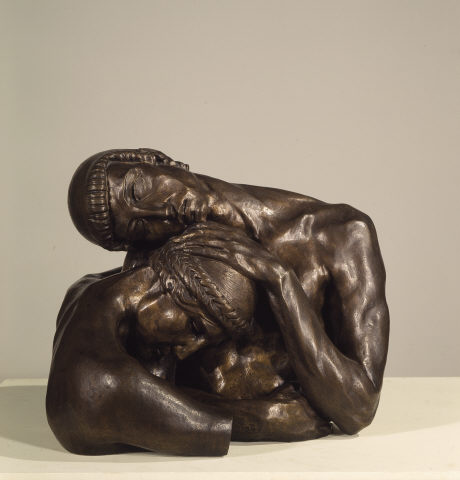
- 1920
- Bronze
- A definir
- Inv. 82E439
Diogo de Macedo
L’ Adieu (O Adeus)
L' Adieu (1920), from the same year the Portuguese sculptor Diogo de Macedo returned to Paris, is generally considered the most modern example of his work. The unusual pose and garments, which highlight the figures' anatomy, and the emotive and introspective quality of the setting, was a modernisation of certain prevailing naturalist codes, and was the greatest example of the renewal of the expressionist Portuguese sculpture, with clear echoes of Bourdelle and Rodin. L' Adieu took formal motifs (as did Canto da Maya) of a modern idea of ancient Greek sculpture – from the idealism of the nude to the floral head-dress, – and accentuated the tensions so as to achieve a maximum expressiveness in the figures' gestures, show the freedom of their gestures, and create a tremendously tactile effect.
Despite the clearly metaphorical nature of the work – entitled L' Adieu or, L' Adieu ou Le Pardon –, there is no attempt to illustrate an abstract or universal concept in the style of a conventional symbolist iconography. On the contrary, using a neo-romantic strategy, it expresses and suggests a most personal and almost incommunicable sense of intimacy. The protective gesture of the male figure, supporting the female figure and surrounding her with his arms (which, despite the cut-off point, invites observers to reconstruct the intimate scene), and the closed eyes and necks stretched towards each other, makes them seem unaware of the outer world that is observing them; they vibrate with pain and affection, and challenge the rigid nature of the bronze. The critical and public reception of this pioneering expressionist work was immediate: it was copied in several plaster models, and was circulated in photographs in the magazines of a generation that had been marked by exiles and losses,* thereby ensuring its position as a masterpiece in the history of Portuguese modernist art.
Afonso Ramos
March 2013
* The image was reproduced in, among other magazines, Contemporânea, vol. I, no 1, April 1922, and Ilustração Portuguesa, second series, first semester of 1922.
| Type | Value | Unit | Section |
| Height | 47 | cm | |
| Width | 56,5 | cm | |
| Depth | 42 | cm |
| Type | signature |
| Type | date |
| Type | location |
| Type | A definir |